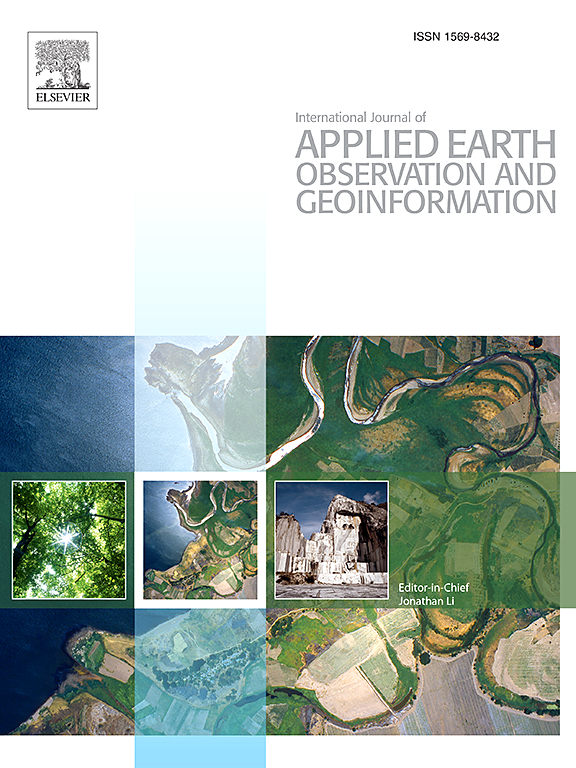Measuring soil moisture change and surface erosion from sparse rainstorms in hyper-arid terrains
IF 8.6
Q1 REMOTE SENSING
International journal of applied earth observation and geoinformation : ITC journal
Pub Date : 2025-06-20
DOI:10.1016/j.jag.2025.104642
引用次数: 0
Abstract
Soil moisture change and surface erosion provide unique insight into the evolution of desert ecohydrology and geomorphology in hyper-arid areas under increasing hydroclimatic extremes. However, the spatial and temporal distributions of the transitional changes in soil moisture and surface erosion associated with sparse rainstorm events are not yet well-characterized due to the low spatial resolution (a few kilometers) of the current microwave radiometer and scarce temporal acquisition and SAR orbital observations, respectively. To address this deficiency, we apply three processing techniques to monitor these changes at a spatial resolution of 45–105 m and with a limited dataset covering four precipitation events of different magnitudes over the hyper-arid Qatar peninsula from 2017 to 2019. Two of the techniques are based on radar interferometric coherence using Sentinel-1C-band satellite data, as the investigated rainstorm events generate measurable isolated changes in the time-series coherence associated with variations in transient soil moisture and surface erosion. The third technique employs soil moisture indices derived from Sentinel-2 multi-spectral satellite imagery. Our observations indicate that the timing of satellite acquisitions relative to a rainstorm is the primary factor in selecting the appropriate technique for identifying soil moisture change, surface erosion, or both. As a result, we integrate these three techniques into a decision-tree to guide users in their methodological choices. Moreover, this decision-tree approach can further improve the assessment of erosion hotspots, flood risks and ecohydrological and geomorphological changes of deserts caused by the current fluctuations in rainstorm events over hyper-arid areas due to hydroclimate volatility.
测量极端干旱地区稀疏暴雨引起的土壤水分变化和地表侵蚀
土壤水分变化和地表侵蚀为研究极端水文气候条件下超干旱区荒漠生态水文地貌演变提供了独特视角。然而,由于目前微波辐射计的空间分辨率较低(几公里),以及时间采集和SAR轨道观测的稀缺,土壤湿度和地表侵蚀的过渡性变化的时空分布尚未得到很好的表征。为了解决这一不足,我们采用了三种处理技术,在45-105 m的空间分辨率下监测了这些变化,并使用了一个有限的数据集,涵盖了2017 - 2019年极度干旱的卡塔尔半岛上四个不同量级的降水事件。其中两项技术基于雷达干涉相干性,使用sentinel - 1c波段卫星数据,因为所研究的暴雨事件在与瞬态土壤湿度和地表侵蚀变化相关的时间序列相干性中产生可测量的孤立变化。第三种技术采用来自Sentinel-2多光谱卫星图像的土壤湿度指数。我们的观察结果表明,在选择合适的技术来识别土壤湿度变化、地表侵蚀或两者时,卫星采集与暴雨相关的时间是主要因素。因此,我们将这三种技术集成到决策树中,以指导用户进行方法选择。此外,该决策树方法还可以进一步完善水文气候波动导致的超干旱区当前暴雨事件波动对沙漠侵蚀热点、洪水风险和生态水文地貌变化的评估。
本文章由计算机程序翻译,如有差异,请以英文原文为准。
求助全文
约1分钟内获得全文
求助全文
来源期刊

International journal of applied earth observation and geoinformation : ITC journal
Global and Planetary Change, Management, Monitoring, Policy and Law, Earth-Surface Processes, Computers in Earth Sciences
CiteScore
12.00
自引率
0.00%
发文量
0
审稿时长
77 days
期刊介绍:
The International Journal of Applied Earth Observation and Geoinformation publishes original papers that utilize earth observation data for natural resource and environmental inventory and management. These data primarily originate from remote sensing platforms, including satellites and aircraft, supplemented by surface and subsurface measurements. Addressing natural resources such as forests, agricultural land, soils, and water, as well as environmental concerns like biodiversity, land degradation, and hazards, the journal explores conceptual and data-driven approaches. It covers geoinformation themes like capturing, databasing, visualization, interpretation, data quality, and spatial uncertainty.
 求助内容:
求助内容: 应助结果提醒方式:
应助结果提醒方式:


